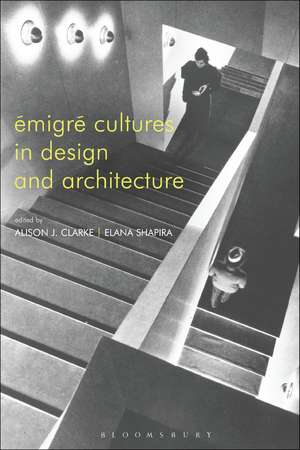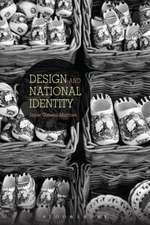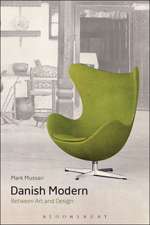Émigré Cultures in Design and Architecture
Editat de Alison J. Clarke, Elana Shapiraen Limba Engleză Paperback – 20 feb 2019
| Toate formatele și edițiile | Preț | Express |
|---|---|---|
| Paperback (1) | 225.16 lei 3-5 săpt. | |
| Bloomsbury Publishing – 20 feb 2019 | 225.16 lei 3-5 săpt. | |
| Hardback (1) | 717.47 lei 6-8 săpt. | |
| Bloomsbury Publishing – noi 2017 | 717.47 lei 6-8 săpt. |
Preț: 225.16 lei
Preț vechi: 258.62 lei
-13% Nou
Puncte Express: 338
Preț estimativ în valută:
43.10€ • 46.83$ • 36.23£
43.10€ • 46.83$ • 36.23£
Carte disponibilă
Livrare economică 31 martie-14 aprilie
Preluare comenzi: 021 569.72.76
Specificații
ISBN-13: 9781350099258
ISBN-10: 1350099252
Pagini: 264
Ilustrații: 49 BW illus
Dimensiuni: 156 x 234 x 13 mm
Greutate: 0.39 kg
Editura: Bloomsbury Publishing
Colecția Bloomsbury Visual Arts
Locul publicării:London, United Kingdom
ISBN-10: 1350099252
Pagini: 264
Ilustrații: 49 BW illus
Dimensiuni: 156 x 234 x 13 mm
Greutate: 0.39 kg
Editura: Bloomsbury Publishing
Colecția Bloomsbury Visual Arts
Locul publicării:London, United Kingdom
Caracteristici
Editor Alison Clarke is well known and highly regarded, and the contributors include high profile design and architectural historians, such as Eve Blau and Pat Kirkham
Notă biografică
Alison J. Clarke is professor of design history and director of the Papanek Foundation, University of Applied Arts Vienna, Austria. She is the editor of Design Anthropology: Object Culture in the 21st Century (2010) and the author of Tupperware: The Promise of Plastic in 1950s America (2014), and of the forthcoming Designer for the Real World: Victor Papanek and 1970s Design Activism.Elana Shapira is a lecturer of design history and theory, and a senior researcher in the ÉmigréCultural Networks project at the University of Applied Arts Vienna, Austria. She is the author of the forthcoming title Style and Seduction: Jewish Patrons and Modern Architecture and Design in Fin de Siècle Vienna.
Cuprins
Introduction - Elana Shapira and Alison J. ClarkeI. Social Transformation and Mass Consumption 1. Isotype and Architectural Knowledge - Eve Blau2. (Mis)Understanding Consumption. Expertise and Consumer Policies in Vienna, 1918-1938 - Oliver Kühschelm3. Shaping the Mass Mind: Frederick Kiesler and the Psychology of Selling - Barnaby HaranII. Assimilation, Emancipation and modern Pluralism 4. Becoming American: Paul T. Frankl's Passage to a New Design Aesthetic - Christopher Long5. Paul László and the Atomic Future - Monica Penick6. Eva Zeisel: Gender, Design, Modernism - Pat KirkhamIII. "Outsiders" Perspectives and Cultural Critique 7. Real and Imagined Networks of an Émigré Biography: Victor J. Papanek Social Designer - Alison J. Clarke8. Kiesler, Rudofsky, and Papanek: the Question of Gender - Elana Shapira9. Felix Augenfeld: Modern Architecture, Psychoanalysis and Antifascism - Ruth HanischIV. Emigration and Education - Bauhaus in the USA 10. György Kepes's "Universities of Vision: From Education in Design to Design as Education of the Mind - Anna Vallye11. The Architectonics of Perception: Xanti Schawinsky at Black Mountain College - Eva DíazV. Envisioning a Global Home12. Between Culture and Biology: Schindler and Neutra at the Limits of Architecture - Todd Cronan13. Bernard Rudofsky: Not at Home - Felicity D. ScottReferencesIndex
Recenzii
.its scholarly contribution to the ongoing critical discussion of early 20th century modernism and the influence of the European experience, and a newly lived American experience, offers a worthwhile read.
This innovative anthology on the émigré and exile experience of designers and architects in the United States invigorates the long-overlooked theories of Vilém Flusser, who argued that transnational cultural production in exile was essentially dialogic. Rather than dwelling on exile as an experience of loss and isolation, the authors in this book consider concepts such as otherness and creativity, European modernism and American commodity culture, local assimilation and global imaginations, and the hybrid tensions between past and present to consider various exilic design languages.
By taking émigré cultures in the plural this set of essays reaches a nuanced understanding of the experience many designers of Central European origin entailed when negotiating their new identities in 20th-century America. The book addresses contributions both to new design thinking as well as anti-design languages, and in this, it is an original and important contribution.
Émigré Cultures in Design and Architecture provides much-needed analysis about how European émigré designers and architects engaged with America during the twentieth-century, an episode previously alluded to mostly in passing. These new essays advance our understanding of the complexity of these encounters, explaining what was gained, what was lost, and what is still be learned from them.
This innovative anthology on the émigré and exile experience of designers and architects in the United States invigorates the long-overlooked theories of Vilém Flusser, who argued that transnational cultural production in exile was essentially dialogic. Rather than dwelling on exile as an experience of loss and isolation, the authors in this book consider concepts such as otherness and creativity, European modernism and American commodity culture, local assimilation and global imaginations, and the hybrid tensions between past and present to consider various exilic design languages.
By taking émigré cultures in the plural this set of essays reaches a nuanced understanding of the experience many designers of Central European origin entailed when negotiating their new identities in 20th-century America. The book addresses contributions both to new design thinking as well as anti-design languages, and in this, it is an original and important contribution.
Émigré Cultures in Design and Architecture provides much-needed analysis about how European émigré designers and architects engaged with America during the twentieth-century, an episode previously alluded to mostly in passing. These new essays advance our understanding of the complexity of these encounters, explaining what was gained, what was lost, and what is still be learned from them.








